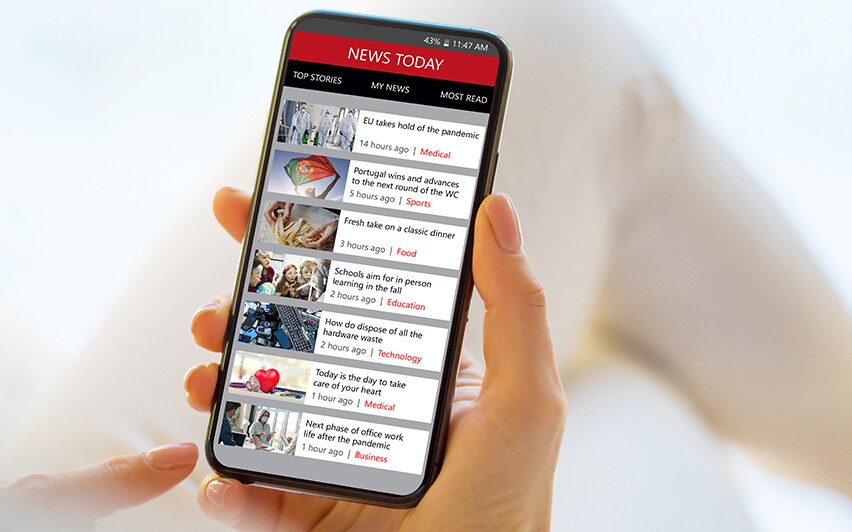Why Engaging New Audiences is Essential for the Future of Broadcasting
TV audiences—and the technologies they rely on—are continuing to change

It’s no secret that traditional television viewership is continuing to come under pressure from the explosion of other digital platforms. As a result, attracting audiences and driving advertising revenue is the universal challenge facing news broadcasters globally.
The simple issue is that today’s consumers have so many more options available to them. Instead of having to sit down in front of a TV at a designated time, they can quickly and easily view the latest headlines, watch live broadcasts and access on-demand programming from wherever they are, whenever they want.
This shift has been acutely demonstrated over recent months, where TV ratings and viewership figures have continued to fall. In primetime TV, perennial ratings leader Fox News topped the charts with an average of 2.13 million viewers in June 2021—a 42% decrease from the previous year. Going back to Q3 2020, data from Nielsen shows that the amount of time 18-34-year-olds spent watching traditional TV dropped by 23%.
News stations therefore need to adjust their approach to finding new audiences and tailor their content for viewers who may be watching on a phone or online. The onus is firmly on broadcasters to adapt—or lose out to those that do.
Know Your Audience
When it comes to adapting to audience expectations, news broadcasters must understand that viewers are no longer attracted to the traditional formulaic approach. This is largely because most people don’t sit down at five o'clock to watch the news. Instead, they’re constantly consuming content on their phones, iPads or desktops through social media.
According to a recent Pew Research Center survey, 86% of US adults get their news from digital devices. Alternatively, 52% prefer to get their news through a digital platform such as news websites or apps, search engines and social media.
This presents news broadcasters with an opportunity to really understand what makes their audience tick. Social media platforms give news broadcasters access to in-depth data analytics about how audiences operate across the digital landscape. Unlike traditional TV, the likes of Facebook and YouTube provide granular visibility into how viewers engage with specific types of content. Broadcasters can see comments and reactions in real-time, and quickly identify what works and what doesn’t.
This information can help to shape platform-specific editorial decision making and further optimize content producing strategies. For example, if a broadcaster sees that a particular story performs well on YouTube, it can then create similar stories to drive brand awareness and audience growth on that specific platform.
At a time when news broadcasters are constantly trying to understand their audiences better, the data provided by digital platforms is invaluable. Real-time analytics into which stories are resonating, how they’re resonating and what viewers are saying about them can help to direct editorial strategies in a way that wasn’t previously possible – giving broadcasters the confidence that people care about the stories they’re producing.
Most importantly, it means news broadcasters will be creating the type of stories that attract wider audiences. This is key to the shift currently taking place. News broadcasters now have greater insight into what audiences care about, thereby increasing the focus on producing original stories that audiences actually want – and then delivering them in the right format. However, they also need to balance this with the reality of being a news station and also retain the independence to produce stories on a wide range of subjects.
Put The Platform First
In today’s era of mobile news, optimizing a story for multiple platforms has become essential. Rather than just sending the program to as many places as possible, news broadcasters must pay closer attention to the user experience. They must be ‘platform cognizant’ by creating different versions of a story or a news segment and tailoring it to specific platforms.
A story just for TV has different requirements to one for YouTube or Twitter. Technical details such as subtitles, production formats and aspect ratios all need to be considered in order to ensure that viewers accessing news on mobile devices get the best possible experience.
Adapting content in this way is now vital to attracting new audiences. Today’s viewers are increasingly fragmented and demand a high-quality experience. They won’t hesitate to turn to a different source if the experience falls short, so optimizing content for different digital platforms is essential to reaching wider audiences and retaining viewers. It may involve producing four or five versions of the same story, but that’s what is required to reach the biggest possible audience.
Ultimately, TV audiences—and the technologies they rely on—are continuing to change. In response, modern news broadcasters must be prepared to provide a diverse range of content and distribute it to a range of different places if they truly want to grow their audiences.
This requires an acceptance that the traditional news model is no longer as effective as it once was. News broadcasters must be able to deliver content wherever, whenever the audience wants it. Most importantly, that content must be optimized so that these audiences get the best possible experience. That’s the key to growing audiences in today’s era of ‘always on’ news consumption.
Get the TV Tech Newsletter
The professional video industry's #1 source for news, trends and product and tech information. Sign up below.
Craig Wilson is Product Evangelist - Media and Cloud at Avid
